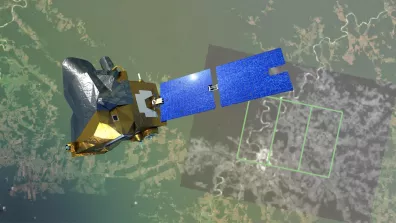MicroCarb is designed to map sources and sinks of carbon dioxide (CO2)—the most important greenhouse gas—on a global scale. This microsatellite was launched during the night of July 25-26, 2025.
Key information
| Mission | Measure global atmospheric CO2 distribution |
|---|---|
| Domain | Earth observation |
| Launch date | July 25, 2025 at 10:03 PM local time (July 26 at 2:03 AM UTC) |
| Partners | CNRS, CEA, Meteo France, universities, European Union / ESA, UKSA, SCGI (ex-CGI) |
| Where | Circular Sun-synchronous orbit at an altitude of 650 km |
| Lifetime | 5 years |
| Status | In operation |
Key figures
- 180 kg: satellite mass
- 1 ppm measurement accuracy for CO2 concentration in Earth’s atmospheric column
- 25-day revisit cycle, 4.5 x 9 km ground pixel resolution at equator
- 2 x 2 km maximum spatial resolution
Key milestones
- July 2025: Launch of MicroCarb by Vega C
- 26 January 2024: Satellite delivered by Thales Alenia Space UK to CNES
- 7 December 2022: Instrument delivered by Airbus Defence & Space to CNES
- 1 July 2017: Transition to Phase C/D of development
- 2015: MicroCarb project go-ahead in wake of COP21, funded by PIA future investment programme
Project in brief
What are our planet’s main carbon sinks: tropical rainforests or the oceans? How many tonnes of CO2 are released by the world’s cities, vegetation and oceans? As surprising as it may seem, we don't know how much CO2 is absorbed and released in certain parts of the world, due to a scarcity of ground-based measuring stations. Nor do we know how these amounts vary with the seasons. Yet this type of information is crucial for understanding the causes and consequences of climate warming, as CO2 is the main human-induced greenhouse gas.
To fill in these gaps in our knowledge, NASA launched the OCO-2 satellite in 2014. By 2025, CNES will take over this role with the launch of MicroCarb. The satellite’s dispersive spectrometer instrument will measure atmospheric concentration of CO2 globally with a high degree of precision—on the order of 1 ppm—and with a pixel size of 4.5 km x 9 km.
CNES’s role
The instrument will be flown on a microsatellite built around CNES’s Myriade spacecraft bus. This mission involves the French scientific community studying climatology and the carbon cycle. It will be funded by the government’s PIA future investment programme.
Contacts
MicroCarb Project Leader
Philippe Landiech
E-mail: philippe.landiech at cnes.fr
System Manager
Didier Pradines
E-mail: didier.pradines at cnes.fr
Performance Manager
Denis Jouglet
E-mail: denis.jouglet at cnes.fr
Instrument Manager
Elodie Cansot
E-mail: elodie.cansot at cnes.fr
Satellite Manager
Emilie Limasset
E-mail: emilie.limasset at cnes.fr
Atmospheric Composition & Carbon Cycle subject matter expert
Carole Deniel
E-mail: carole.deniel at cnes.fr





